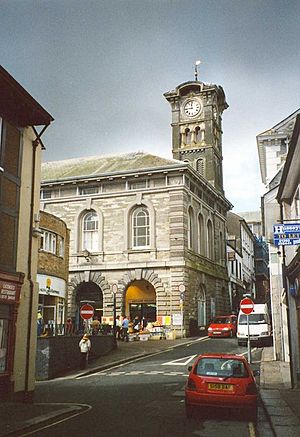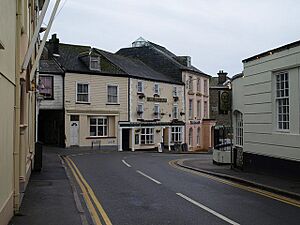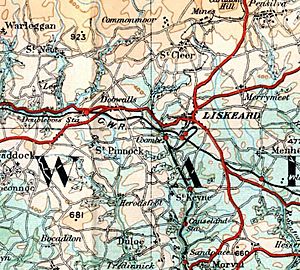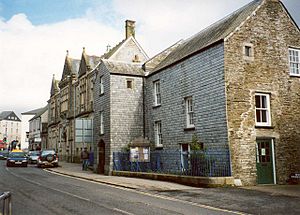Liskeard facts for kids
Quick facts for kids Liskeard
|
|
|---|---|
 Liskeard Guildhall (2001) |
|
| Lua error in Module:Location_map at line 530: Unable to find the specified location map definition: "Module:Location map/data/Cornwall (mainland)" does not exist. | |
| Population | 10,307 (2011) |
| OS grid reference | SX251645 |
| Civil parish |
|
| Unitary authority | |
| Ceremonial county | |
| Region | |
| Country | England |
| Sovereign state | United Kingdom |
| Post town | LISKEARD |
| Postcode district | PL14 |
| Dialling code | 01579 |
| Police | Devon and Cornwall |
| Fire | Cornwall |
| Ambulance | South Western |
| EU Parliament | South West England |
| UK Parliament |
|
Liskeard (pronounced lih-SKARD) is an old market town in south-east Cornwall, England. It's known for its history as a "stannary town," which means it was important for tin mining.
The town is about 20 miles (32 km) west of Plymouth and 12 miles (20 km) east of Bodmin. The beautiful Bodmin Moor is just to the north-west. In 2011, about 11,366 people lived in Liskeard.
Contents
History of Liskeard
The name Liskeard comes from the Cornish language. The word Lis means 'court' or 'palace'. This suggests that Liskeard was once a very important place where kings or powerful leaders held their courts.
One early king, King Dungarth, who lived in the 8th century, is thought to have had his court here. Liskeard was already an important area by the time of the Domesday Book survey. This was a big record of England made by William the Conqueror in 1086.
After the Norman Conquest, a Norman castle was built in Liskeard. Over time, the castle was no longer used and fell apart. By the 1500s, only small parts of it remained.
Liskeard was one of the 17 "ancient manors" of the Duchy of Cornwall. A market was officially allowed in Liskeard in 1240 by Richard, Earl of Cornwall. This made Liskeard a key place for farming and trade.
The town became very rich during the time of tin mining before the 1900s. It was a main centre for the tin industry. This is why it was called a "stannary town" – a place where tin was weighed and taxed.
The main road, the A38, used to go right through the town centre. Now, a bypass takes traffic around the south of the town. This makes the town centre much quieter and easier to visit.
Liskeard Today
Liskeard used to have a regular market for farm animals, but this stopped in 2017. Today, you can find many restaurants, cafes, and pubs in the town. Some shops still have their old Victorian fronts and insides, which is cool to see!
The town has many fun events throughout the year. In January, there's a pantomime show. Every June, Liskeard holds a lively carnival. In July, there's a big farming event called The Liskeard Show.
The St Matthew's Fair, which started way back in 1266, was brought back in 1976. It happens in September or October. In December, Liskeard celebrates 'Liskeard Lights Up'. This is when the Christmas lights are turned on, with street entertainment and a lantern parade.
Important Buildings
Liskeard has St. Martin's Church, which is the second largest parish church in Cornwall. It was built on the site of an older Norman church. The oldest parts of the church you see today are from the 15th century.
Other important buildings include:
- The Foresters Hall: This building now has the Tourist Information Office and the Liskeard & District Museum.
- Stuart House: King Charles I stayed here in 1644 during a war. Today, it's a community building used for arts and events.
- Liskeard Guildhall: Built in 1859, this building has a tall clock tower.
- The Public Hall: This was built in 1890.
- Webb's House: Once a grand hotel, it's now apartments and home to the local newspaper, The Cornish Times.
- Pencubitt House: Built in 1897 for a rich wool merchant.
- The Pipe Well: This is an old holy well.
Education in Liskeard
The first school in Liskeard started in 1550 on Castle Hill. Over the years, different private schools opened. In 1908, the County School was built. After 1945, it became Liskeard Grammar School.
In 1960, Liskeard County Secondary School opened. It was a modern school with lots of space for about 500 students. In 1974, a new part was added.
Today, Liskeard School and Community College is a large school for students aged 11 to 19. It has about 1300 students and around 200 staff members. It's the only school in Cornwall with a special focus on engineering. The school also has a centre for children with autism.
There are two primary schools in Liskeard: St Martin's Church of England School and Hillfort Primary School. There's also Caradon Short Stay School, which helps students aged 11–16 who can't attend a regular school.
Getting Around
Liskeard railway station is on the main train line from London to Penzance. This means you can easily travel to Plymouth and other parts of Cornwall. There's also a smaller train line, the Looe Valley Line, that goes to Looe.
The A38 road also gives good access to the town. Plus, there are regular bus services to different places in Cornwall.
Fun and Sports
Liskeard has a leisure centre at Lux Park where you can do different activities. There's also a bowling club and the Liskerrett Community Centre, which has many sports and hobby groups.
The town has a Non-League football club called Liskeard Athletic F.C. They play at Lux Park. There are also rugby and cricket clubs that are very popular.
Cornish Wrestling History
For hundreds of years, Liskeard has held Cornish wrestling tournaments. These events were held in different fields around the town. One famous wrestler from Liskeard was Abel Werry, who was the champion of Cornwall in the 1700s.
Walking Trails
There are three special walking trails in Liskeard, each with a blue plaque to mark it:
- A path from the town to the railway station, built in 1890 by Thomas Lang, a former mayor.
- A trail around the north of the town centre, including the Parade and a beautiful fountain. The fountain was a gift from Michael Loam, whose father invented the Man engine (a machine used in mines).
- A trail around the southern part of town, remembering Lt. Lapenotière. He was the person who brought the news of the Battle of Trafalgar victory back to England.
Local Media
For TV news, Liskeard gets coverage from BBC South West and ITV West Country. You can listen to local radio stations like BBC Radio Cornwall and Heart West. Liskeard also has its own online community radio station called Liskeard Radio. The local newspaper is The Cornish Times.
Twin Towns
Liskeard is "twinned" with other towns, which means they have a special friendship.
- Since 1974, Liskeard has been twinned with Quimperlé in Brittany, France.
- In December 2023, Liskeard also became twinned with Kopychyntsi in Ukraine.
Famous People from Liskeard
Some notable people from Liskeard include:
- Richard Coad – an architect.
- Emily Hobhouse – a campaigner for welfare.
- Trevor Woodman – a former England rugby player who was part of the team that won the 2003 Rugby World Cup.
Weather in Liskeard
Like the rest of the United Kingdom, Liskeard has an oceanic climate. This means it has mild winters and cool summers, with rain throughout the year.
| Climate data for Liskeard | |||||||||||||
|---|---|---|---|---|---|---|---|---|---|---|---|---|---|
| Month | Jan | Feb | Mar | Apr | May | Jun | Jul | Aug | Sep | Oct | Nov | Dec | Year |
| Mean daily maximum °C (°F) | 8 (46) |
8 (46) |
9 (48) |
12 (54) |
14 (57) |
17 (63) |
19 (66) |
19 (66) |
17 (63) |
14 (57) |
11 (52) |
9 (48) |
13 (55) |
| Mean daily minimum °C (°F) | 3 (37) |
3 (37) |
4 (39) |
5 (41) |
8 (46) |
11 (52) |
13 (55) |
13 (55) |
11 (52) |
9 (48) |
6 (43) |
4 (39) |
8 (46) |
| Source: Weather Channel | |||||||||||||
Freedom of the Town
The "Freedom of the Town" is a special honour given to people or groups.
Military Units
- The Royal British Legion (Liskeard Branch): Received this honour on August 14, 2022.
See also
 In Spanish: Liskeard para niños
In Spanish: Liskeard para niños





